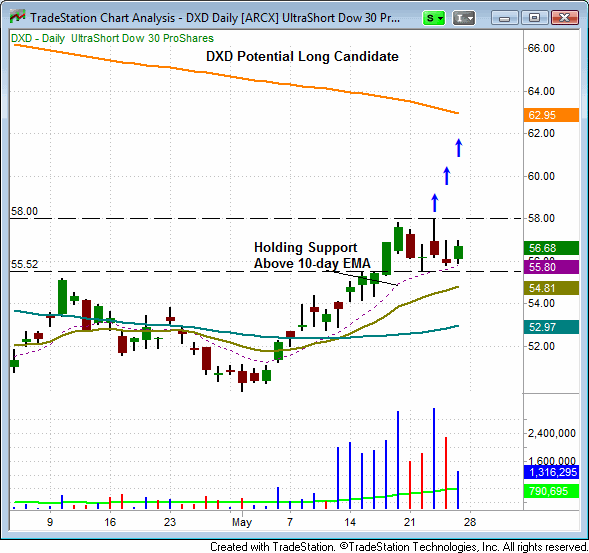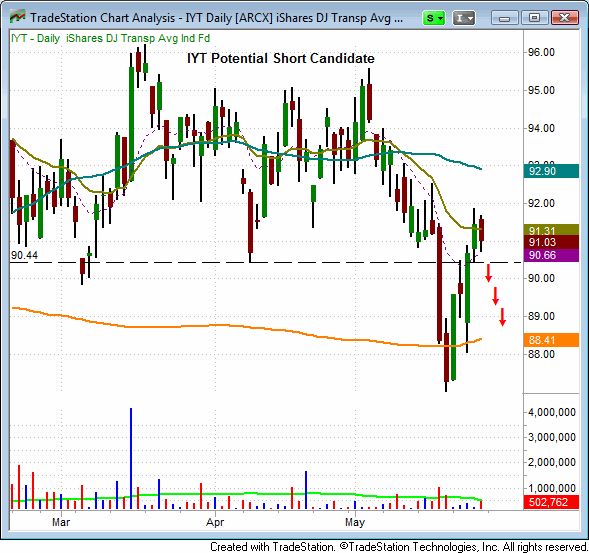Stocks closed modestly lower in the pre-holiday session, while volume not surprisingly eased. The small-cap Russell 2000 demonstrated the most relative strength, as it managed to close flat on the session. The Nasdaq dropped 0.1% on the day. Both the S&P 500 and the S&P MidCap 400 edged 0.2% lower. The Dow Jones Industrial average was the weakest index on the day. By the closing bell, the Blue Chip index shed 0.6%.
For the second time in as many days, market internals were mixed. Volume plunged by 24.2% on the NYSE and declined 26.6% on the Nasdaq. In both the NYSE and Nasdaq, advancing volume slightly outpaced declining volume. Internals were nothing short of uneventful prior to the three-day weekend, and were not indicative of institutional trading activity in either direction.
Over the past seven trading days, the inversely correlated ProShares UltraShort Dow Jones 30 ETF ($DXD) has been holding support above its 10-day EMA, and volume also expanded as DXD recently broke out above its range. The recent high-volume breakout above key resistance at the $55.50 level, followed by lighter volume consolidation, means that a volume-fueled move above the three-day high of $58.00 could present a near-term buying opportunity in this ETF:

If it trades above our trigger price for potential buy entry, note that this DXD trade setup is designed to be very short-term in nature (not more than a few days hold time). Due to the daily rebalancing of derivatives that comprise the portfolio of leveraged and “short ETFs,” these instruments usually underperform their underlying index as holding time increases. Therefore, the leveraged and inverse ETFs are best used for relatively quick, momentum-based trades of just a few days or less.
Last Friday, on an uptick in volume, the iShares Dow Jones Transportation Average Index Fund ($IYT) failed to reclaim support of its 20-day EMA and closed its intraday low. Now, a drop below the two-day low of $90.45 could present a short selling opportunity in this ETF. As such, we are now stalking IYT for potential swing trade entry. Our exact entry, stop, and target prices for this trade setup are available for regular subscribers in the “watchlist” section of today’s Wagner Daily stock newsletter.
As a reminder, we recommend calling your broker prior to the open to ensure that shares of IYT are available for shorting. If not, you might consider opening a secondary account with a direct access broker that caters to active traders (TradeStation and InteractiveBrokers are two such firms). These types of firms typically have a much more extensive list of shares available for selling short than your traditional web-based brokers designed for long-term “buy and hold” investing. Furthermore, there is no inverse transportation ETF available as an alternative to shorting IYT. The technical trade setup for $IYT is illustrated on the chart below:

The broad market has struggled in its attempt to move to higher ground over the past two weeks, and the major indices are now exhibiting “bear flag” patterns on their daily charts. Although we still could see further buying action in the near-term, the longer stocks continue to consolidate near their recent lows, the more likely the next move will be lower. Ideally, we would like to see the main stock market indexes bounce for a few days this week, as this would provide a better reward to risk ratio for new short entries in weak stocks and ETFs, but the stock market could just as easily head lower from the current levels without bouncing.
The commentary above is an excerpt from The Wagner Daily swing trader stock newsletter. Subscribers to the full version also receive our exact entry and exit prices for swing trade setups of the best stocks and ETFs, as well as access to both our market timing model and proven trading strategy. You may test drive our stock newsletter with the top stock picks and ETFs risk-free for 30 days.
